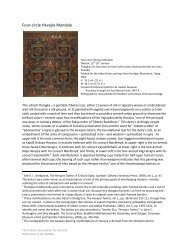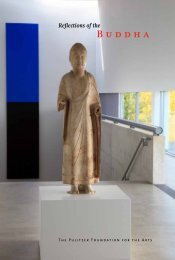Womb World Mandala (TaizÅkai mandara) - Reflections of the Buddha
Womb World Mandala (TaizÅkai mandara) - Reflections of the Buddha
Womb World Mandala (TaizÅkai mandara) - Reflections of the Buddha
Create successful ePaper yourself
Turn your PDF publications into a flip-book with our unique Google optimized e-Paper software.
<strong>Womb</strong> <strong>World</strong> <strong>Mandala</strong> (Taizōkai <strong>Mandala</strong>) 6<br />
The Barnet-Burto Collection mandala, executed in fine gold lines on indigo-dyed silk, is an excellent<br />
example <strong>of</strong> balance between <strong>the</strong> geometrical symmetry <strong>of</strong> <strong>the</strong> architectural structure and <strong>the</strong> pr<strong>of</strong>usion<br />
<strong>of</strong> varied figures. More than four hundred deities are given a convincing sense <strong>of</strong> volume despite <strong>the</strong>ir<br />
simplified contours; <strong>the</strong> s<strong>of</strong>tly curving strokes are able to convey a sense <strong>of</strong> <strong>the</strong> deities’ dynamic<br />
movement and interaction in <strong>the</strong> densely populated space, which is delineated more abruptly by <strong>the</strong><br />
application <strong>of</strong> cut-gold leaf or foil used for <strong>the</strong> major horizontal and vertical lines separating <strong>the</strong><br />
different courts, and <strong>the</strong> central lotus petals. 18 Aside from its obvious material value and signification <strong>of</strong><br />
preciousness, gold represents <strong>the</strong> perfection <strong>of</strong> <strong>the</strong> <strong>Buddha</strong>’s great wisdom, and <strong>the</strong> indigo-blue<br />
background represents <strong>the</strong> lapis lazuli, <strong>the</strong> stone from which <strong>the</strong> <strong>Buddha</strong>’s palace is built. 19 Many<br />
examples <strong>of</strong> <strong>the</strong> Two <strong>World</strong>s mandala are executed in polychrome; in this example, however, <strong>the</strong> only<br />
colored pigment is <strong>the</strong> red line that signifies compassion that is painted around <strong>the</strong> central lotus section<br />
(discussed below). It is rare to have works in gold and indigo in this state <strong>of</strong> preservation and scale from<br />
<strong>the</strong> Kamakura period (1185-1333) or earlier outside <strong>of</strong> <strong>the</strong> major Esoteric temples in Japan.<br />
In <strong>the</strong> center <strong>of</strong> <strong>the</strong> mandala, a fully opened eight-petalled lotus flower holds <strong>the</strong> <strong>Buddha</strong> Vairocana,<br />
jeweled and garlanded and in princely raiment, surrounded by eight petals on which are seated four<br />
<strong>Buddha</strong>s and four Bodhisattvas, toge<strong>the</strong>r representing <strong>the</strong> nine kinds <strong>of</strong> consciousnesses. As <strong>the</strong><br />
mandala radiates outwards from <strong>the</strong> center, <strong>the</strong> deities and <strong>the</strong> meanings <strong>the</strong>y represent become<br />
progressively more concerned with <strong>the</strong> phenomenal world, that is, with <strong>the</strong> practical functioning <strong>of</strong><br />
knowledge and <strong>the</strong> senses ra<strong>the</strong>r than with <strong>the</strong>ir conceptual purity. 20 Although <strong>the</strong> iconography <strong>of</strong> each<br />
18 John Rosenfield and Elizabeth ten Grotenhuis, Journey <strong>of</strong> <strong>the</strong> Three Jewels: Japanese Buddhist Paintings from<br />
Western Collections. New York: Tuttle (1979), p. 76.<br />
The Takao mandala is a famous large-scale example from <strong>the</strong> ninth century <strong>of</strong> a mandala <strong>of</strong> that also utilizes cut<br />
gold and silver foil on precious purple-dyed silk. A comparable eleventh century example is held in <strong>the</strong> Kojima-ji<br />
子 島 寺 in Nara, but even smaller scale versions <strong>of</strong> mandala produced by this method are rare (Ariga Yoshitaka in<br />
<strong>Buddha</strong>’s Smile - Masterpieces <strong>of</strong> Japanese Buddhist Art. Tokyo: London Gallery Ltd. (2002) cat. 99). Buddhist<br />
sutras had been copied in gold onto indigo dyed paper and silk from <strong>the</strong> eighth century, and it seems that <strong>the</strong><br />
same aes<strong>the</strong>tic is at work in <strong>the</strong>se mandala, and likely <strong>the</strong> same craftsmen were involved in <strong>the</strong>ir production. For<br />
an example in China, see <strong>the</strong> Guanyin Chapter from an Illustrated Lotus Sutra also in this exhibition.<br />
19 As described in <strong>the</strong> Visualization Sutra 観 無 量 寿 経 (Japanese, Kanmuryōjūkyō).<br />
20 John Rosenfield and Elizabeth ten Grotenhuis, Journey <strong>of</strong> <strong>the</strong> Three Jewels: Japanese Buddhist Paintings from<br />
Western Collections. New York: Tuttle (1979), p. 76. Some deities, such as <strong>the</strong> bodhisattvas Jizō and Kannon, are<br />
repeated in different manifestations at different locations throughout <strong>the</strong> mandala to represent <strong>the</strong>ir different<br />
attributes in different situations and worlds.<br />
The Pulitzer Foundation for <strong>the</strong> Arts<br />
<strong>Reflections</strong> <strong>of</strong> <strong>the</strong> <strong>Buddha</strong>




